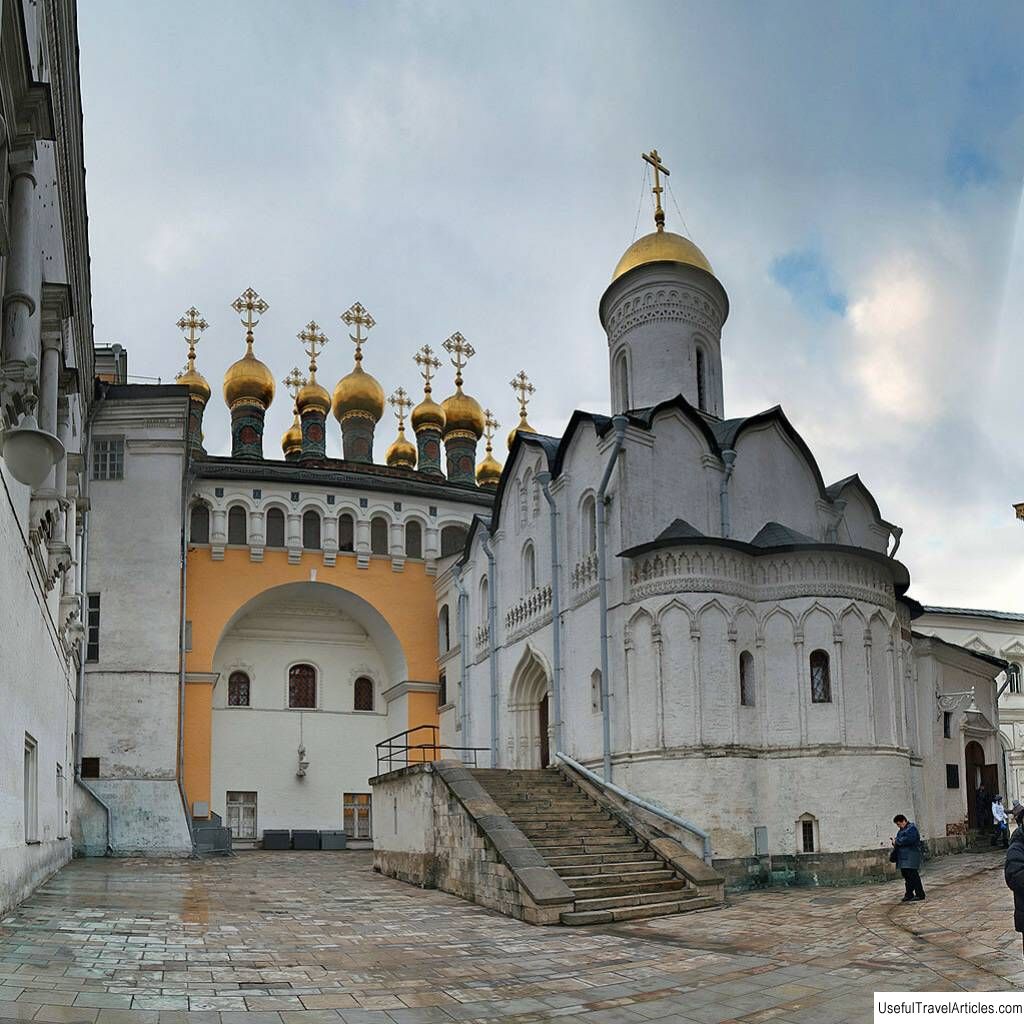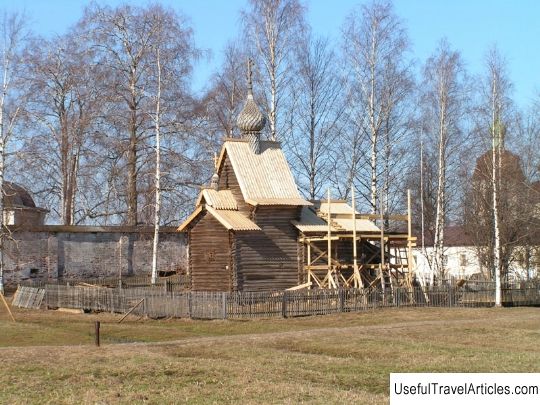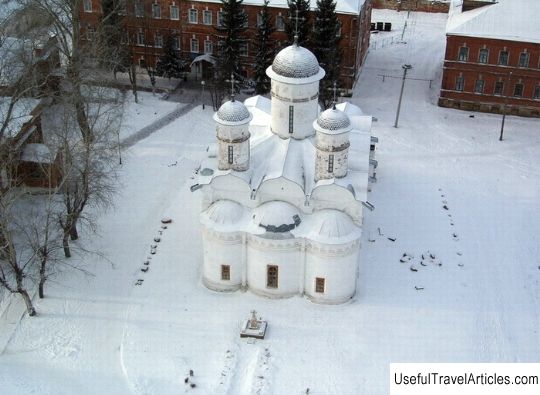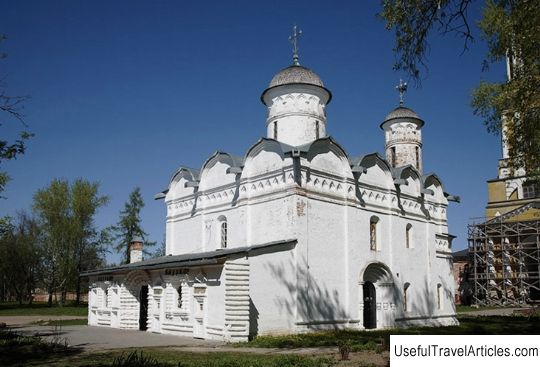Church of the Deposition of the Robe in the Kremlin description and photos - Russia - Moscow: Moscow
Rating: 7,8/10 (988 votes) 
Church of the Deposition of the Robe in the Kremlin description and photos - Russia - Moscow: Moscow. Detailed information about the attraction. Description, photos and a map showing the nearest significant objects. Photo and descriptionA church dedicated to the Robe of the Most Holy Theotokos was built on Cathedral Square on the territory of the Moscow Kremlin at the end of the 15th century. A relic revered in Orthodoxy, the Robe of the Mother of God, after it was acquired in the middle of the 5th century, was laid in a church built specifically for this on the shores of the Blachernae Bay in Constantinople. On the day this happened, the Orthodox Church celebrates the Feast of the Deposition of the Robe. During the time that the relic was in the Blachernae Church , many miracles were associated with it. In 1434, the temple where the Robe of the Mother of God was kept died in a fire, and the sacred relic was lost. Particles of the Robe, miraculously found in different places, are kept in several churches in Russia, Italy and Georgia, consecrated in honor of the Feast of the Robe Deposition. History of the construction of the Church of the Deposition of the RobeThe first church in honor of the Feast of the Deposition of the Robe was built in the Moscow Kremlin by St. Jonah . The Metropolitan ordered to build a house church in honor of deliverance from the next invasion of the Golden Horde, which happened in 1451 on the day when the bright feast of the Deposition of the Robe was celebrated. The church served as a home church for the Moscow metropolitans until it burned down in 1472 along with the rest of the buildings of the metropolitan's yard. The next Church of the Deposition of the Robe appeared on Cathedral Square in 1485. It was built by Pskov architects who arrived in Moscow by order of Metropolitan Gerontius . The temple was consecrated, but it also stood for just over half a century. Another fire brought great destruction to Moscow, and the Church of the Deposition of the Robe suffered no less than others. The new reconstruction brought significant changes to the appearance of the temple: two portals made of white stone were replaced with brick ones. At the beginning of the 17th century, the Kremlin was occupied by the Polish-Lithuanian garrison and its churches were partially destroyed and plundered. Another fire added problems, and therefore in 1627 the building was thoroughly repaired again and even a new iconostasis was created. A team of icon painters, commanded by Nazariy Istomin Savin , worked on the writing of the images. A couple of decades later, Patriarch Joseph , who lacked light in the Church of the Deposition of the Robe, ordered to widen the slit-like windows and paint the walls with new frescoes depicting scenes from the life of the Savior, the Mother of God and the biblical prophets. From the Tsar's Church to the Moscow Kremlin Museum In the 30s of the XVII century began construction of the Patriarchal Palace and the Church of the Twelve Apostles. After its completion, the Church of the Deposition of the Robe lost the functions of the patriarchal house church and was transferred to the order of the king. It was connected by a staircase to the Terem Palace. A little later, architectural changes again affected the Church of the Deposition of the Robe: the rebuilding of the porches into closed galleries made it possible to arrange a chapel in them, consecrated in honor of the Pechersk Icon of the Mother of God . The first half of the 18th century is the time when when the temple was almost abandoned. Money for repairs and heating was not allocated, the dampness destroyed the frescoes, and in 1737 there was also a severe fire. After a natural disaster, the miraculous Pechersk Icon of the Mother of God was closed in an iron icon case. Then came the French, who plundered the temple in 1812, along with the rest of the Orthodox churches and cathedrals in Moscow. Serious repairs took place in the mid-19th century , when the roof of the Church of the Deposition of the Robe was repaired, the floors were replaced, the corridors were re-painted and the wall frescoes restored. After the revolution, the temple was closed. In 1918, the artist Igor Grabar created a committee to preserve and restore the monuments of ancient architectural architecture. The Church of the Robe Deposition was included in the restoration program. In 1950, work began on the disclosure of early wall paintings and the restoration of the ancient iconostasis. The architectural appearance of the templeThe Church of the Deposition of the Robe in the Moscow Kremlin was built in accordance with the traditions of the so-called Russian architecture - a direction whose roots go back to Byzantium and the Old Russian state. A distinctive feature of Russian architecture is the white stone construction technique, which was first used in the construction of the churches of Vladimir, Pereslavl and Suzdal under Yuri Dolgorukov . High basement , on where the Church of the Deposition of the Robe stands, keeled ends of its walls, vertically dividing the facade of columns and strict platbands of windows over the frieze give the building both laconicism and significance. The gilded dome of the church in the form of a helmet of a Russian warrior, friezes from terracotta balusters, ornamental plates and capitals in the form of sheaves add expressiveness and elegance to the temple. The interior of the church is fully consistent with its original purpose - to serve as a home temple and a place where one could offer prayer in silence and without the fuss of a large crowd. The peculiarity of the interior decoration lies in the amazing harmony of all components - from the iconostasis to wall paintings and works of applied art. Murals Preserved to this day and the frescoes of the temple restored in the twentieth century were made in 1644 by a team of artists, which included famous Russian icon painters Semyon Abramov, Ivan Borisov and Sidor Pospeev . They worked for about three months and, most likely, were guided by the previous painting system. It dates back to 1605, although it is believed that the first frescoes appeared immediately after the construction of the temple in the middle of the 15th century. During an excursion to the Church of the Deposition of the Robe, you should pay attention to the following murals: - The canonical arrangement of the frescoes suggests that the central plot is in the dome. In the Church of the Deposition of the Robe, this is an image of Christ the Almighty , the upper belt of the drum is occupied by the figures of the Old Testament prophets, and the lower tier is dedicated to the evangelists. - On the western pillars of the temple there are portraits of Russian princes , canonized, and metropolitans . Eastern pillars and arches connecting them to the wall are occupied with images of the church fathers. - The wall paintings are mostly devoted to the theme of praise of the Virgin, in honor of the Robe of which the temple was built. The frescoes are located in four tiers - the biography of the Virgin Mary occupies the upper two, and the Great Akathist glorifying her - the lower ones. - The vaults of the temple and the upper levels of the pillars contain portraits of saints who were considered patrons of the house Romanovs. They are made in the form of medallions. The slopes of the windows are occupied by images of holy monks, seraphim and cherubim. - The altar part of the church is painted like the Assumption Cathedral of the Moscow Kremlin. In the upper part of the central apse you can see the composition of the Great Entrance, and on the wall of the apse - the composition of the Cathedral of All Saints. - The lower tier of the walls of the Church of the Deposition of the Robe is covered with ornamental painting , called a "towel". The frescoes of this part of the church resemble the fabric decor with which it was customary to close the walls in order to protect them from the constant touch of the clothes of the praying parishioners. The light and festive atmosphere of the church is undoubtedly the merit of the icon painters who used white, blue paints in their work. turquoise and ocher tones. The frescoes and murals look harmonious and colorful and blend perfectly with the architectural elements of the temple. Iconostasis of the Church of the Deposition of the Robe The ancient tyabla iconostases are altar partitions, consisting of several horizontal rows. In every row called the rank, there are icons painted, as a rule, by one artel of icon painters. The most significant and valuable images are placed in the central part of each tier. In the Church of the Robe Deposition in the Moscow Kremlin, the iconostasis belongs to the same type, and the main complex of its icons was painted in 1627 by the brigade Nazariy Istomin Savin by order of Patriarch Filaret. The craftsmen created images for the three upper ranks of the iconostasis - deesis, festive and prophetic. The lowest tier, called the local one, contains two icons of Nazariy Istomin Savin - the recently uncovered Our Lady of Hodegetria , painted in full growth, and the Old Testament Trinity . They are located to the left of the Royal Doors of the temple. The iconostasis of the Church of the Deposition of the Robe in the Moscow Kremlin is one of the most significant works of Nazariy Istomin Savin. Coming from a family of icon painters, the master fulfilled many orders of the sovereign and patriarchal in his life. His paintings are characterized by an impeccable execution technique, sophistication of images and a special color character of icons, which is called Savin's unique pictorial style, recognizable among many others. Russian wooden sculpture of the 15th-19th centuriesExhibition from this name was opened in the Church of the Deposition of the Robe in 1965, although the first exposition dedicated to Old Russian sculpture appeared in the temple in the 1920s. It began to collect N. N. Pomerantsev , whose whole life was devoted to the preservation of the monuments of ancient Russian culture. The first exhibition was opened in 1923 in the refectory of the church in the Ascension Monastery . Its exhibits are rarities from the temples closed by the new government and nationalized private collections. The Ascension monastery on the territory of the Moscow Kremlin was demolished in 1929, after which the exhibits from the exhibition were sent to the Kremlin museum. They were kept in storerooms until 1965, when the exhibition reopened, but already in the Church of the Deposition of the Robe. On the museum stands you can see statues of saints, skillfully carved from wood, carved images and their frames, decorated with figured carving household items and church utensils. The oldest exhibits in the collection are dated to the 15th century . In the 15th-19th centuries, church carving became widespread, and the exposition in the Church of the Deposition of the Robe contains works, made by craftsmen from Vladimir, Novgorod, Perm, Moscow and cities of the Russian North. Note:
     We also recommend reading Volcan Llullaillaco description and photos - Chile: Antofagasta Topic: Church of the Deposition of the Robe in the Kremlin description and photos - Russia - Moscow: Moscow. |





